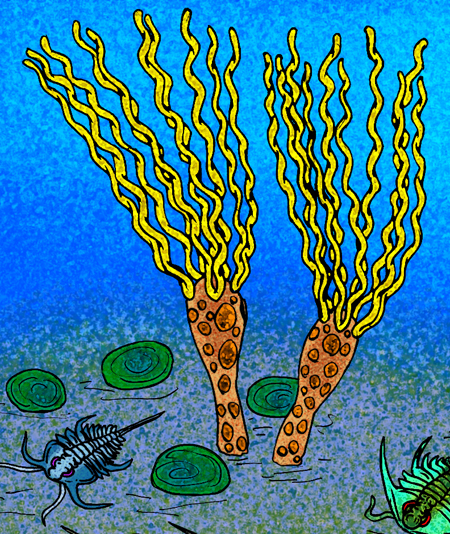Gogia Ojenai on:
[Wikipedia]
[Google]
[Amazon]

 ''Gogia'' is a
''Gogia'' is a

 ''Gogia'' is a
''Gogia'' is a genus
Genus ( plural genera ) is a taxonomic rank used in the biological classification of extant taxon, living and fossil organisms as well as Virus classification#ICTV classification, viruses. In the hierarchy of biological classification, genus com ...
of primitive eocrinoid
The Eocrinoidea are an extinct class of echinoderms that lived between the Early Cambrian and Late Silurian periods. They are the earliest known group of stalked, arm-bearing echinoderms, and were the most common echinoderms during the Cambrian.
...
blastozoa
Blastozoa is a subphylum of extinct animals belonging to Phylum Echinodermata. This subphylum is characterized by the presence of specialized respiratory structures and brachiole plates used for feeding. This subphylum ranged from the Cambrian to ...
n from the early to middle Cambrian
Middle or The Middle may refer to:
* Centre (geometry), the point equally distant from the outer limits.
Places
* Middle (sheading), a subdivision of the Isle of Man
* Middle Bay (disambiguation)
* Middle Brook (disambiguation)
* Middle Creek (di ...
.
''G. ojenai'' dates to the late Early Cambrian; other species
In biology, a species is the basic unit of classification and a taxonomic rank of an organism, as well as a unit of biodiversity. A species is often defined as the largest group of organisms in which any two individuals of the appropriate s ...
come from various Middle Cambrian strata throughout North America, but the genus has yet to be described outside this continent
A continent is any of several large landmasses. Generally identified by convention rather than any strict criteria, up to seven geographical regions are commonly regarded as continents. Ordered from largest in area to smallest, these seven ...
. Notable localities where species are found include the Wheeler Shale
The Wheeler Shale (named by Charles Walcott) is a Cambrian ( 507 Ma) fossil locality world-famous
for prolific agnostid and '' Elrathia kingii'' trilobite remains (even though many areas are barren of fossils)
and represents a Konzen ...
of Utah
Utah ( , ) is a state in the Mountain West subregion of the Western United States. Utah is a landlocked U.S. state bordered to its east by Colorado, to its northeast by Wyoming, to its north by Idaho, to its south by Arizona, and to it ...
, and the Burgess Shale
The Burgess Shale is a fossil-bearing deposit exposed in the Canadian Rockies of British Columbia, Canada. It is famous for the exceptional preservation of the soft parts of its fossils. At old (middle Cambrian), it is one of the earliest foss ...
of British Columbia
British Columbia (commonly abbreviated as BC) is the westernmost province of Canada, situated between the Pacific Ocean and the Rocky Mountains. It has a diverse geography, with rugged landscapes that include rocky coastlines, sandy beaches, ...
.
The species of ''Gogia'', like other eocrinoids, were not closely related to the true crinoid
Crinoids are marine animals that make up the class Crinoidea. Crinoids that are attached to the sea bottom by a stalk in their adult form are commonly called sea lilies, while the unstalked forms are called feather stars or comatulids, which are ...
s, instead, being more closely related to the blastoid
Blastoids (class Blastoidea) are an extinct type of stemmed echinoderm, often referred to as sea buds. They first appear, along with many other echinoderm classes, in the Ordovician period, and reached their greatest diversity in the Mississ ...
s.
''Gogia'' is distinguished from sea lilies, and most other blastoids, in that the plate-covered body was shaped like a vase, or a bowling pin (with the pin part stuck into the substrate), and that the five ambulacra
Ambulacrum is an architectural word that denotes an atrium, courtyard, or parvise in front of a basilica or church that is surrounded by arcades or colonnades, or trees, and which often contains a fountain
A fountain, from the Latin "f ...
were split into pairs of coiled or straight, ribbon-like strands. Six specimens of ''Gogia'' are known from the Greater Phyllopod bed
The Phyllopod bed, designated by USNM locality number 35k, is the most famous fossil-bearing member of the Burgess Shale fossil ''Lagerstätte''. It was quarried by Charles Walcott from 1911–1917 (and later named Walcott Quarry), and was t ...
, where they comprise < 0.1% of the community.
As a whole, the Eocrinoids are regarded as basal blastozoans very close to the ancestry of the entire subphylum.
References
External links
* Burgess Shale fossils Burgess Shale animals Cambrian echinoderms Blastozoa genera Cambrian genus extinctions Wheeler Shale Paleozoic life of Alberta {{paleo-echinoderm-stub